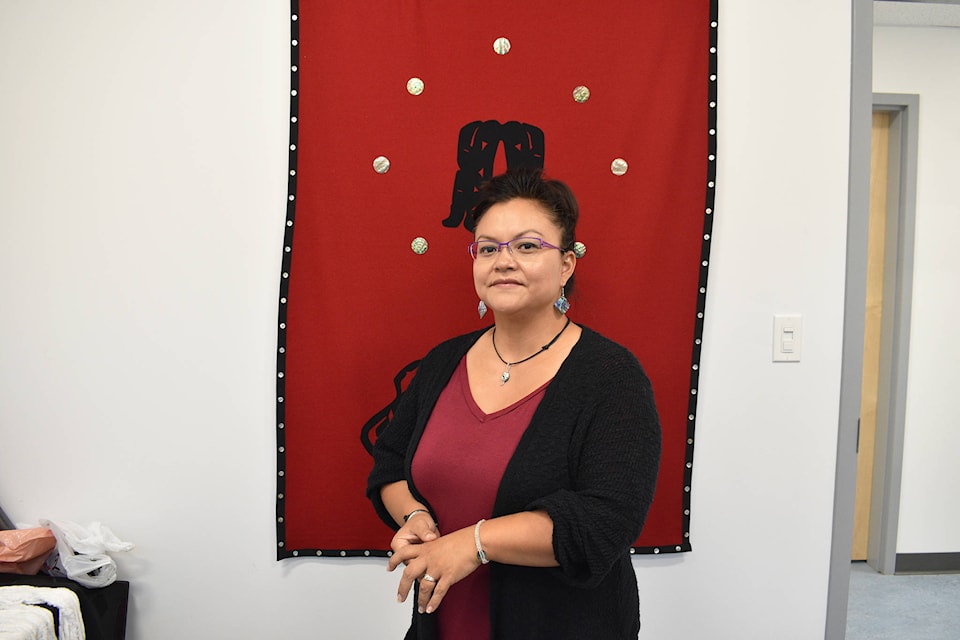Lynn Parker walks over to the red tapestry she had made, hanging on the wall of her office at the Kermode Friendship Society main building.
Her mother’s Gitxsan frog clan image of the Nikate’en House is sewn in the centre of eight abalone buttons. Below sits a frog intertwined with an eagle, her husband’s clan, intricately cut out of black fabric and woven in against the red.
“If you notice, the frog will always have a rounded nose, and nothing ever touches — that’s the trick,” Lynn says, referring to the linework.
Items memorializing her Gitxsan and Tsimshian heritage command the room. Devil’s Club used for making jewellery, salve and tea sits on a table across her desk; cedar bark sheets for weaving lay curled in a basket, and her son’s carved wooden spoon accompanies the framed photos she has of her family.
The mother of four stepped into the position of cultural sensitivity and decolonization worker at Kermode a few months ago. Through her work, she organizes classes on cedar weaving, assists with sweat lodge ceremonies, beading workshops and language classes alongside her elders group. She also plans to work with the eight surrounding First Nations, to learn more about their culture and language, and bring it back for the members who live in Terrace. Her job now is the one she’s been waiting to take on for years.
“When you say, what is decolonization for Indigenous peoples, it’s described as ongoing theoretical and political processes to contest and reframe narratives about Indigenous community history, and the effects of colonial expansion, genocide and cultural assimilation,” she says.
READ MORE: Kitselas holds first elder knowledge gathering event
“What the government wants to do with reconciliation… it’s a bigger job than anybody could handle. Considering 80,000 of those children now have their own families, and I’m one of them.”
Lynn’s grandfather on her father’s side was one of the 150,000 children to go through the Canadian residential school system. She learned how the trauma affected him, how he guarded himself. She saw how that same trauma was passed down to her father, and the hardships that followed him from his upbringing. She herself struggled with alcohol and addiction as a way to cope before adopting a substance-free lifestyle for the last 11 years with her husband, Daniel Parker.
“You look back at what was taken from my grandpa, his innocence was taken. His childhood was taken. Reconciling is not only your culture, your language, but your person,” she says.
When Lynn was three years old, her house in Kitselas burnt down, leaving nothing but ashes. Tragically, her father had passed away at the same time. Left to start over, her family moved to the Kalum Trailer Park in Terrace and began transitioning to a new life in the city. Lynn wouldn’t return to Kitselas until 13 years later when she was 16 years old.
“Growing up in the trailer park and going through all the hardships of school…all of the supports we have nowadays weren’t there when I was growing up. I walked through a lot of racism — you had to learn to be tough, and knowing more than the bully.”
Lynn’s family remained proud of who they were and where they came from despite this. She remembers helping her grandfather on her mother’s side with his potato farm and harvesting fish and berries together as a family in the Cranberry Junction area off of the Nisga’a Highway.
She began discovering and learning more about her heritage and who she was over time. In school, when she faced ignorant and racist remarks from some of the other children, she used this knowledge as a powerful tool.
“That’s how I faced it, I challenged them on what they knew about me and what they knew about my culture,” Lynn says. “I would tell them, I’m not making fun of you and your heritage, and I expect the same.”
READ MORE: Federal Court approves settlement agreement for Indian day schools
A week after she graduated high school, Lynn was hired to work as a teller at the Royal Bank of Canada Terrace branch. She says she remembers an older couple standing in line, and when they saw her, they said “Oh no, it’s okay. We’ll wait for the next teller.”
“That was the most insulting thing that I’ve ever come across at an adult level,” she says.
The couple came in a few more times and eventually allowed Lynn to help them. After a while, the couple would stand in line and wait until Lynn was free.
“It just goes to show you after teaching somebody more about who you are, it really makes them change their perspective of who you are.”
For Lynn, reconciliation is being able to live and breathe First Nations culture, and having her children be proud to know who they are and where they came from is essential.
“The whole point of residential school was to kill the Indian in the child. The fact that we are still here and we know who we are is our strength. You see people and you want to commend them for their walk, because it wasn’t easy. It wasn’t easy to get to where I am.
“My whole life I’ve been travelling down two separate streets parallel to each other. Two separate roads. One side of the road is my traditional side, and one side is the modern side. Walking down in the centre of those two roads is very hard, sometimes, to keep it even. Trying to find where I am, where I belong, and how I belong. So, I made my own space. And in doing that, you walk tall. When you walk down that path between traditional and modern, you have to own it.”
brittany@terracestandard.com
Like us on Facebook and follow us on Twitter
